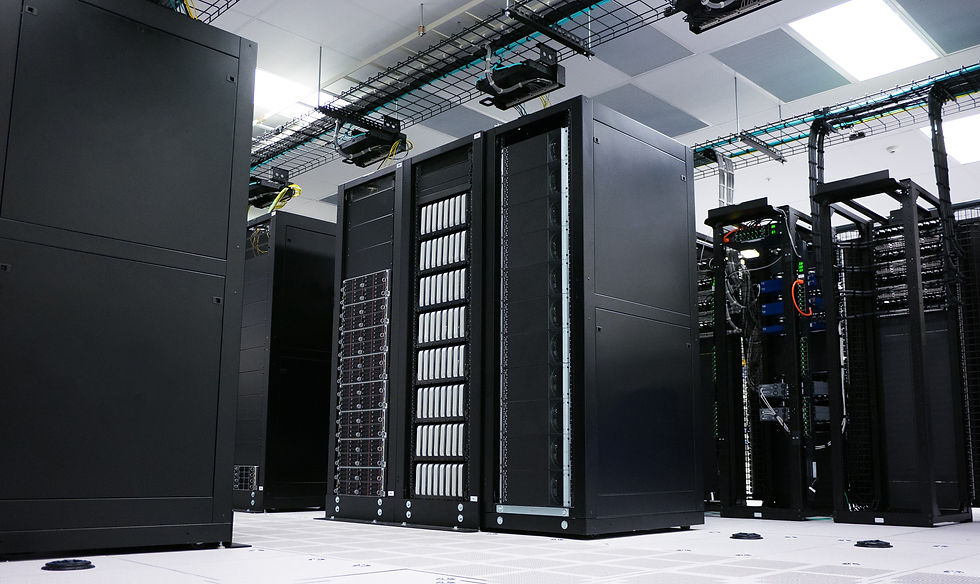Transitioning PeopleSoft To The Cloud: Questions & Answers
- kmeyer53
- Aug 14, 2022
- 8 min read
Updated: Sep 5, 2022
As Oracle’s PeopleSoft customers look to the future and consider the benefits of cloud solutions, they often have questions about transitioning to the cloud and the options available to them.
Let's start with the basics, then work our way up.

What does “in the cloud” mean?
Two primary characteristics define enterprise solutions as being in the cloud:
1. The solution is not located on hardware that you own and maintain on your own premises.
2. Users subscribe to the solution rather than paying up front for a perpetual license. The subscription fees cover technical support, and the solution provider applies patches and updates to the solution on your behalf.

PeopleSoft applications are not in the cloud. They are traditional software applications sold through a perpetual license with annual maintenance fees, and they have historically been deployed on-premises. The many options for cloud deployment broadly fall into two categories: SaaS (software as a service) and IaaS (infrastructure as a service).
SaaS and Oracle Fusion Cloud Applications: Oracle Fusion Cloud Applications support the same business processes as PeopleSoft. Many on-premises customers have completely shifted to Oracle Cloud Applications, while others are integrating PeopleSoft with Oracle Cloud Applications to augment or add functionality.
IaaS for PeopleSoft: PeopleSoft applications can be run on Oracle Cloud Infrastructure (OCI). Rather than buying and maintaining hardware and network components, customers can instead subscribe to physical hardware and storage capacity and use these to run PeopleSoft.
How do PeopleSoft customers benefit from cloud adoption?

The primary advantages of migrating from PeopleSoft to Oracle Cloud Applications include a lower total cost of ownership (TCO) and the ease of staying current with software, security, and technology. Unlike on-premises PeopleSoft systems, there is no hardware to purchase or maintain. Maintenance tasks, such as applying security and technical patches as well as maintaining the operating system and applying updates, are all performed by Oracle. This reduces overhead costs across IT resources, including hardware and services provided by system administrators. Many organizations also find cloud adoption compelling because IT operations are not their core competency. By outsourcing system hardware, infrastructure, and maintenance to Oracle, organizations can better focus their time, energy, and resources on strategic initiatives, competitive differentiators, and other critical areas. Other benefits associated with the cloud include:
Do PeopleSoft customers have to move to the cloud?
No.
As a PeopleSoft customer, you can continue to run PeopleSoft for as long as it meets your organization’s needs. Oracle continues to invest in PeopleSoft with regulatory updates, functional enhancements, simplified and automated system administration, and strategic new capabilities that drive digital process transformation. New PeopleSoft features are available quarterly, with hundreds of new capabilities added every year.
In addition, Oracle extended Support for PeopleSoft until at least 2032. If this option is too expensive for your needs there are less costly options for premium PeopleSoft support.
While PeopleSoft customers can continue using their current system, a growing number of companies are choosing to move to Oracle Cloud Applications. By doing so, they benefit from a cloud approach that offers subscription-based applications, industry-leading analytics capabilities, and an infinitely scalable infrastructure to support their global business needs.
What are Oracle Cloud Applications? Oracle Cloud Applications are a comprehensive suite of SaaS applications for running all aspects of your business, including finance, HR, operations, supply chain, and more. Engineered to work together, all Oracle Cloud Applications share a common data model that unites business functions to seamlessly connect your business, processes, and people. Our complete suite of cloud applications includes Oracle Fusion Cloud ERP and Oracle Supply Chain & Manufacturing (SCM) for organizing and modernizing your financials, risk management, procurement, supply chain, and more. Oracle’s human capital management (HCM) and advertising and customer experience (CX) cloud applications provide organizations with HR, workforce planning, and payroll as well as marketing, sales, and service.
Can Oracle Cloud Applications meet our needs?
Yes.
As a PeopleSoft customer, you can be confident that Oracle Cloud Applications will help you tackle challenges and position your business for growth. Thousands of customers already successfully manage their organizations with Oracle Cloud Applications.
Oracle Cloud Applications leverage Oracle’s collective experience across many solutions, including PeopleSoft, Agile Product Lifecycle Management, Demantra, Hyperion, JD Edwards, Oracle E-Business Suite, and Siebel Customer Relationship Management.
PeopleSoft customers of all sizes from different industries throughout the world have moved to, or extended their applications with, Oracle Cloud Applications. Their experience has confirmed that Oracle’s enterprise performance management (EPM), ERP, SCM, HCM, and CX cloud functionalities support their requirements today while establishing a strong foundation for the future with next-generation technologies. These applications also support the planning, budgeting, HR, payroll, and CRM functionalities that were previously managed in PeopleSoft.
In recent publications, analyst firm Gartner has named Oracle Cloud Applications as a leader in the categories of ERP, HCM, and EPM. In addition to the thousands of customers using our cloud applications, we also use our own cloud technology to run our global business.
Since solutions and technologies evolve rapidly and have likely changed since you implemented PeopleSoft, we recommend you evaluate Oracle Cloud Applications against your current and future business requirements and objectives rather than using your current system as a checklist for comparison.
Can we use Oracle Cloud Applications with PeopleSoft? Yes. Your PeopleSoft solution can be integrated with Oracle Cloud Applications. By integrating your solution with our cloud applications, you can incrementally move business processes to the cloud as you see fit. Many PeopleSoft customers start their journey to the cloud by implementing components of Oracle Cloud Applications for business processes they don't currently manage with PeopleSoft. For example, if you use PeopleSoft with third-party solutions for planning and budgeting, talent management, or supplier management, you could move those specific functions to Oracle Cloud Applications. Or you might choose to start by adopting the cloud for a specific business unit, department, or an acquired organization.
How do customizations work in Oracle Cloud Applications? Customizations are expensive to build and maintain, and it’s always in your best interest to minimize them with the goal of eventually eliminating them altogether. Customers often acknowledge that they have customizations that could be retired and replaced with similar applications that are available in Oracle Cloud. Oracle has invested heavily to provide you with ways to continue tailoring the solution to your unique needs in the cloud without expensive customizations. Features, such as personalization and form extensions, enable you to retire and replace old customizations. Customers typically use an on-premises-to-cloud project to simplify, standardize, and automate their business processes and use the configuration tools to meet their unique needs. In addition, customers often find that their customizations are related to reporting and are no longer necessary with the robust reporting available in all Oracle Cloud Applications. Many customers find that their IT or business stakeholders already have experience migrating a customized solution to a configurable SaaS solution—which can also make the transition easier than expected. Like all SaaS solutions, Oracle Cloud Applications are configurable instead of customizable. This approach enables us to deploy regular system updates, ensuring your users have access to new features and technologies. This is fundamental, as SaaS solutions have changed the expectations for enterprise software. In this digital era, infrequent updates are a barrier to the software’s ability to contribute value to the organization. The nature of cloud applications ensures that the software will never become obsolete and that organizations permanently stop carrying the unnecessary cost of maintaining tailor-made customizations.
How do integrations work with Oracle Cloud Applications? Many customers have integrated other business systems with PeopleSoft. Those integrations can continue with Oracle Cloud Applications using Oracle Integration Cloud, which enables you to easily and efficiently set up, automate, and manage complex integrations across your application landscape. This includes both cloud-to-cloud and cloud-to-on-premises applications. Oracle Integration Cloud provides integration between Oracle Cloud Applications and virtually any application, service, or datastore. Oracle Integration eliminates barriers between business applications through a combination of prebuilt adapters, process automation templates, and a visual builder for web and mobile app development. Prebuilt application adapters and integration flows simplify the technical aspects of dealing with low-level APIs. This makes SaaS integration 6 to 10 times faster while reducing upgrade risks. Process automation brings agility with an easy, visual, low-code platform.
How are Oracle Cloud Applications maintained? Oracle Cloud Applications are maintained with automatic, quarterly system updates. You can deploy (enable, configure, and use) these updates on your schedule. It’s important to monitor the new features that are released and planned for each quarterly update. When deploying updates, we recommended testing to ensure business processes run properly and proactively communicating updates to users as they are deployed. Existing PeopleSoft customers who use a continuous adoption process will have a smooth transition to this model of consuming updates.
Where can I hear from other customers about their journey from PeopleSoft to Oracle Cloud Applications? Many PeopleSoft customers from a variety of industries and geographic areas have successfully moved to Oracle Cloud Applications, each taking a unique path that best supported their business needs. Here are examples of PeopleSoft customers who have either moved to or extended their system using Oracle Cloud Applications. Baylor University unites HR and Finance with Oracle (1:42) How MetLife made the journey to the cloud (1:15)
Where can PeopleSoft customers learn about Oracle Cloud Applications? The PeopleSoft product team hosted a special webinar series for PeopleSoft customers to get answers to common questions about the cloud.
If you'd like more immediate answers, the team at Meyer will be happy to speak with you about any issue involving Oracle applications and your business.

Meyer has been a leader on Oracle application implementation and support since 1995.
How do we run PeopleSoft on Oracle Cloud Infrastructure? Oracle Cloud Infrastructure is an IaaS platform for building and running applications, such as PeopleSoft.
OCI lets you use the computing, network, and storage capabilities of Oracle Cloud on a subscription basis, increasing automation, speed, and agility while minimizing the cost of hardware and routine maintenance.
OCI provides an infinite amount of capacity that automatically scales up and down. This provides increased performance, improved security, and reduced TCO. With OCI, Oracle manages an all-Oracle stack that includes hardware, database, and applications, which improves overall lifecycle management. Many customers now subscribe to OCI for PeopleSoft and use either PeopleSoft Update Images to create new environments or PeopleSoft Cloud Manager to lift and shift existing on-premises PeopleSoft environments to OCI.
PeopleSoft Cloud Manager can dramatically improve the way you manage PeopleSoft environments, with capabilities such as:
One-click upgrades to the latest PeopleTools release or patch level in OCI;
Policy Manager, which automates environment activities based on your needs;
And templates that can be used for “click-to-provision” environments.
In some cases, customers need ongoing assistance for running PeopleSoft on Oracle Cloud Infrastructure.
For those customers, Meyer provides managed services and day-to-day maintenance and operations of the environment.
Where can I hear from other customers about their journey from PeopleSoft to Oracle Cloud Infrastructure? Many PeopleSoft customers from a variety of industries and geographic areas have successfully made the move to Oracle Cloud Infrastructure, each taking a unique path that best supported their business needs. Here are examples of PeopleSoft customers who have moved their on premises environment to OCI. Alliance Data Systems saves US$1 million by moving to OCI Colombia’s Universidad de la Sabana saves 35% on IT costs by moving to OCI Covanta sees 2X performance improvement with OCI The University of Santiago saves 35% by moving PeopleSoft to OCI
Read the original article at Oracle.com
Looking for info about Oracle? For 27 years, Meyer has been implementing & supporting Oracle PeopleSoft. And now we provide services for Oracle NetSuite, Oracle Cloud Financials, and more.
Visit the Meyer Website or Call 888.MEYER.50

The team at Meyer is ready to help move you forward!





Comments